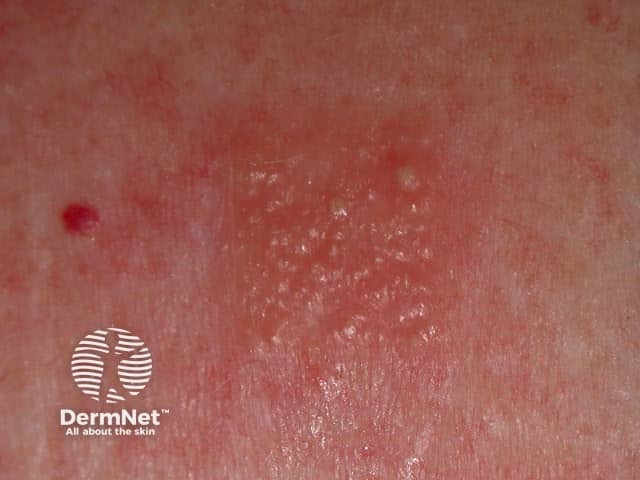Main menu
Common skin conditions

NEWS
Join DermNet PRO
Read more
Quick links
Contact allergy to bufexamac — extra information
Contact allergy to bufexamac
Author: Dr Samra L Saikal, Unaccredited Dermatology Registrar, Lotus Dermatology, Newcastle, NSW, Australia. DermNet Editor in Chief: Adjunct A/Prof Amanda Oakley, Dermatologist, Hamilton, New Zealand. Copy edited by Gus Mitchell/Maria McGivern. August 2018.
Introduction Uses International availability Reactions Diagnosis Adverse reactions
What is bufexamac?
Bufexamac is a topical non-steroidal anti-inflammatory drug (NSAID). It is usually combined with a topical anaesthetic and an antiseptic agent.
Bufexamac is a well-recognised cause of allergic contact dermatitis at the site of application, and it may also cause a widespread polymorphic cutaneous eruption.
What is bufexamac used for?
Bufexamac preparations have been traditionally used to treat insect bites, stings, minor cuts, abrasions, sunburn, thermal burns and inflammatory dermatoses (such as dermatitis) [1,2]. However, there is scarce evidence substantiating its efficacy [3]. It has also been previously manufactured as a suppository for haemorrhoids (piles).
In which countries is bufexamac found?
Due to its adverse effects and establishment as a contact allergen, bufexamac is not available in the following countries as of August 2018 [1,4]:
- New Zealand
- Japan
- European Union (including the United Kingdom)
- United States
- Canada.
As of 2020, it is no longer available in Australia. Bufexamac is still available over the counter in other countries.
What are the reactions to bufexamac?
Bufexamac has been established as a cause of allergic contact dermatitis [4]. It can also result in [1,5–11]:
- Urticaria
- Pruritus
- Oedema
- Blistering
- Peeling
- Erythema multiforme-like reaction
- Acute generalised exanthematous pustulosis
- Pruritic pigmented dermatosis
- Symmetrical drug-related intertriginous and flexural exanthema (SDRIFE).
How is an allergy to bufexamac diagnosed?
An adverse reaction to bufexamac is diagnosed by taking a careful patient history, examining the rash, and patch testing.
An allergic reaction to bufexamac may appear similar to the condition for which bufexamac was being used, so reactions to bufexamac may be underreported.

A positive patch test
How is the adverse reaction to bufexamac treated?
The use of bufexamac should be stopped and it should be avoided in the long term.
Any resulting dermatitis is treated with topical corticosteroids and emollients.
References
- Medsafe New Zealand. Consideration of bufexamac-containing medicines indicated for the relief of dermatitis, rash and hives under Section 36 of the Medicines Act 1981. Minutes of the 145th Medicines Adverse Reactions Committee Meeting — 10 March 2011. Available at: http://www.medsafe.govt.nz/profs/adverse/Minutes145.htm#3.1.1 (accessed August 2018).
- MIMS Online. Pharmacy Action antiseptic cream. August 2018. Available at: www.mimsonline.com.au (accessed August 2018; login required).
- Christiansen JV, Gadborg E, Kleiter I, et al. Efficacy of bufexamac (NFN) cream in skin diseases. A double-blind multicentre trial. Dermatologica 1977; 154: 177–84. PubMed
- Uter W, Schnuch A. EMA revokes marketing authorization for bufexamac. Contact Dermatitis 2011; 64: 235–6. DOI: 10.1111/j.1600-0536.2011.01883.x. PubMed
- Arikawa J, Okabe S, Kaneko T. Allergic contact dermatitis with spreading over extensive regions due to topical use of 5% bufexamac ointment. J Dermatol 2004; 31: 136–8. PubMed
- Fukuda H, Sato Y, Usami N, Yokouchi Y, Mukai H. Contact dermatitis caused by bufexamac sparing the eruption of herpes zoster. J Dermatol 2012; 39: 405–7. DOI: 10.1111/j.1346-8138.2011.01261.x. PubMed
- Koch P, Bahmer FA. Erythema-multiforme-like, urticarial papular and plaque eruptions from bufexamac: report of 4 cases. Contact Dermatitis 1994; 31: 97–101. PubMed
- Kurumaji Y. Photo Koebner phenomenon in erythema-multiforme-like eruption induced by contact dermatitis due to bufexamac. Dermatology 1998; 197: 183–6. PubMed
- Belhadjali H, Ghannouchi N, Nim L, et al. Acute generalized exanthematous pustulosis induced by bufexamac in an atopic girl. Contact Dermatitis 2008; 58: 247–8. DOI: 10.1111/j.1600-0536.2007.01271.x. PubMed
- Waltermann K, Marsch W, Kreft B. [Bufexamac-induced pigmented purpuric eruption]. Hautarzt 2009; 60: 424–7. [Article in German] DOI: 10.1007/s00105-008-1656-2. PubMed
- Proske S, Uter W, Schnuch A, Hartschuh W. [Severe allergic contact dermatitis with generalized spread due to bufexamac presenting as the "baboon" syndrome]. Dtsch Med Wochenschr 2003; 128: 545–7. [Article in German] DOI: 10.1055/s-2003-37850. PubMed
On DermNet
Other websites
- Summary of data on the benefits and risks for bufexamac-containing medicines indicated for the relief of dermatitis, rash and hives — Medsafe [risk–benefit review].
